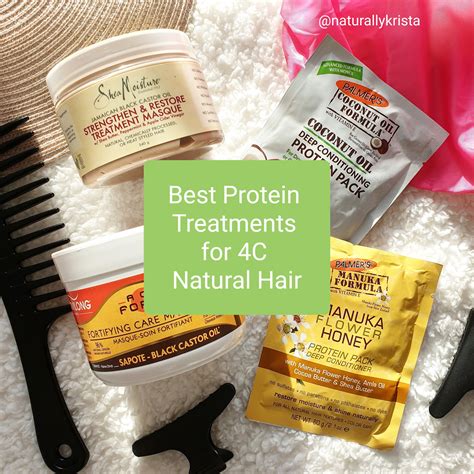Hair, a crowning glory for many, is susceptible to damage from environmental stressors, chemical treatments, and heat styling. This damage can result in weakened, brittle strands prone to breakage, split ends, and dullness. Fortunately, nature provides an effective solution: protein treatments.

What is Protein Treatment for Hair?
Protein treatment is a process involving the addition of external proteins to hair shafts to strengthen them. Hair is largely composed of a protein called keratin, which gives it its strength and elasticity. Damage can cause keratin loss, leading to weakened strands. Protein treatments replenish this lost protein, revitalizing hair and restoring its integrity.
Benefits of Natural Protein Hair Treatments
Enhanced Strength: Protein treatments bind to hair cuticles, filling in gaps and adding strength to individual strands. This reduces breakage, split ends, and overall hair loss.
Improved Elasticity: Healthy hair is elastic and can withstand stretching without breaking. Protein treatments increase hair’s elasticity, making it more resilient to damage.
Hydration Boost: Proteins attract and retain moisture, giving hair a hydrated and moisturized appearance. This helps combat dryness, frizz, and tangles.
Reduced Frizz and Flyaways: Protein treatments smooth hair cuticles, reducing frizz, flyaways, and static electricity.
Added Shine and Gloss: Healthy, well-nourished hair reflects light better, resulting in increased shine and gloss.
Natural Sources of Hair Proteins
Eggs: Rich in protein, amino acids, and biotin, eggs are an excellent natural hair treatment.
Yogurt: Contains lactic acid, which exfoliates hair and scalp, and protein that strengthens hair.
Avocados: A powerhouse of protein, vitamins, and healthy fats, avocados nourish and moisturize hair.
Bananas: Rich in potassium and natural oils, bananas add strength, moisture, and shine to hair.
Beans and Lentils: Legumes are abundant in protein and moisture-boosting ingredients, making them ideal for hair treatments.
DIY Natural Protein Treatment Recipes
Egg Mask: Whisk together one egg and 1 tablespoon of olive oil. Apply to hair from roots to tips, leave for 20 minutes, and rinse.
Yogurt Mask: Mix 1/2 cup of plain yogurt with 1 tablespoon of honey. Apply to hair, leave for 30 minutes, and rinse.
Avocado Mask: Mash one ripe avocado with 1 tablespoon of olive oil. Apply to hair, leave for 20 minutes, and rinse.
Banana Mask: Puree one ripe banana with 1 tablespoon of plain yogurt. Apply to hair, leave for 30 minutes, and rinse.
Professional Protein Treatments
Professional protein treatments offer more concentrated and controlled application methods. They can be classified into two types:
Keratin Treatments: Formulated with a high concentration of keratin, these treatments penetrate hair shafts, filling in gaps and smoothing cuticles.
Bonding Treatments: These treatments repair broken disulfide bonds in hair, restoring strength and elasticity.
Table 1: Comparison of Natural vs. Professional Protein Treatments
| Feature | Natural Treatments | Professional Treatments |
|---|---|---|
| Ingredients | Natural proteins from food | Synthetic or natural-derived proteins |
| Concentration | Lower | Higher |
| Application | DIY or at-home | Salon or professional |
| Cost | Affordable | More expensive |
| Results | Gradual improvement | Faster, more noticeable results |
Common Mistakes to Avoid
- Over-Proteinizing: Excessive protein treatment can lead to hair becoming stiff, brittle, and prone to breakage.
- Using Harsh Ingredients: Avoid treatments containing harsh sulfates or alcohol, which can strip hair of natural oils.
- Skipping Regular Conditioning: Protein treatments do not replace conditioners. Continue to use a regular conditioner to maintain hair’s moisture balance.
- Exposing Hair to Heat: Heat styling can damage hair treated with proteins. Use heat protectants when blow-drying or using styling tools.
- Applying Treatments Too Often: Protein treatments should be used 1-2 times per month for optimal results.
Table 2: Pros and Cons of Natural Protein Hair Treatments
| Pros | Cons |
|---|---|
| Affordable | Can be messy to apply |
| Easy to make at home | May not provide long-lasting results |
| Nourishing and moisturizing | Can weigh down fine hair |
| Gentle on hair | May require multiple treatments for significant results |
Table 3: Benefits of Professional Protein Treatments
| Benefit |
|—|—|
| Enhanced strength and elasticity |
| Reduced frizz and flyaways |
| Increased moisture and shine |
| Long-lasting results |
Table 4: Considerations for Professional Protein Treatment
| Factor | Considerations |
|---|---|
| Hair Type | Fine hair may be unsuitable for intense protein treatments |
| Previous Chemical Treatments | Pre-bleached or chemically straightened hair may require special treatment |
| Time Commitment | Treatments can take several hours |
| Cost | Professional treatments are more expensive than DIY options |
| Maintenance | Follow-up treatments may be required to maintain results |
FAQs
1. How often should I use protein treatments?
Natural protein treatments can be used 1-2 times per month. Professional treatments typically require less frequent application.
2. Can I leave protein treatments in my hair overnight?
Leaving natural protein treatments overnight can result in hair becoming stiff and brittle. Professional treatments generally should not be left in overnight.
3. What is the difference between protein and moisture treatments?
Protein treatments strengthen hair, while moisture treatments hydrate it. Both are essential for healthy hair.
4. Can I use protein treatments on all hair types?
Most hair types can benefit from protein treatments. However, fine or over-processed hair may require a lighter approach.
5. What is a hydrolized protein treatment?
Hydrolized proteins are broken down into smaller molecules, allowing them to penetrate hair shafts more effectively.
6. Is it possible to have too much protein in hair?
Yes, excessive protein can cause hair to become stiff, inelastic, and prone to breakage.
7. Can I use protein treatments on color-treated hair?
Yes, but it is recommended to use gentler treatments formulated for color-treated hair.
8. What are some creative applications for protein treatments?
Protein treatments can be used as pre-styling protectors, leave-in conditioners, or hair masks for intensive care.
